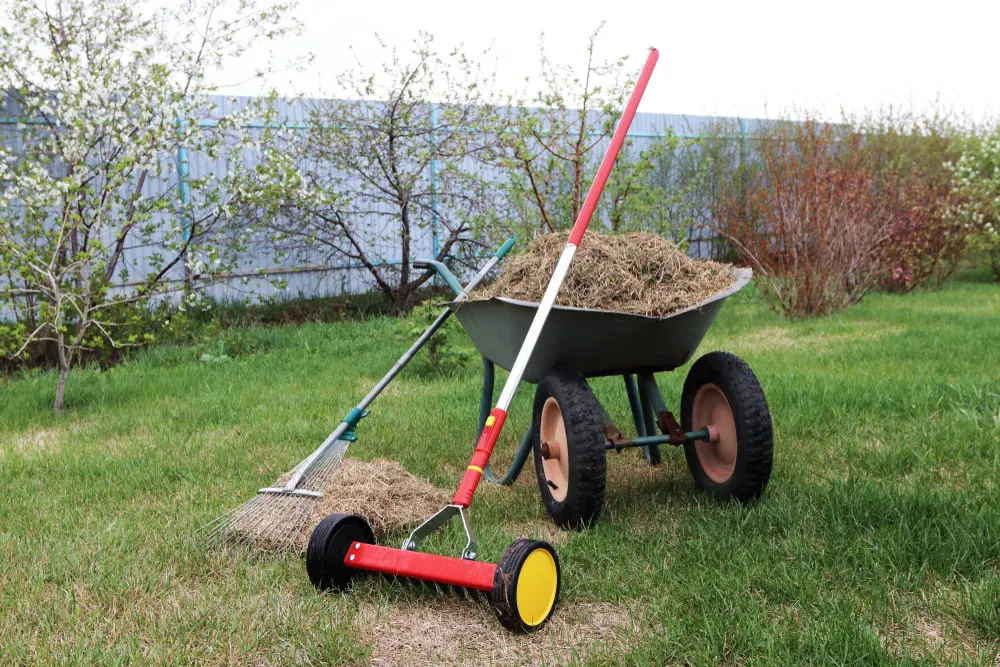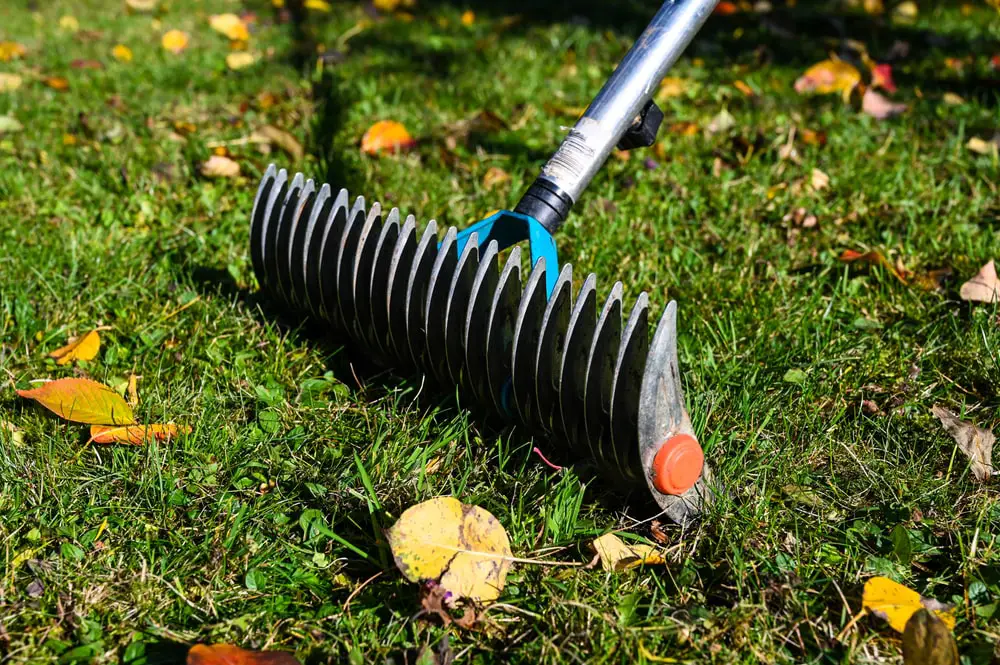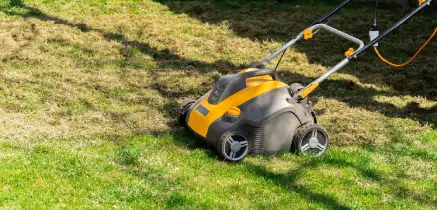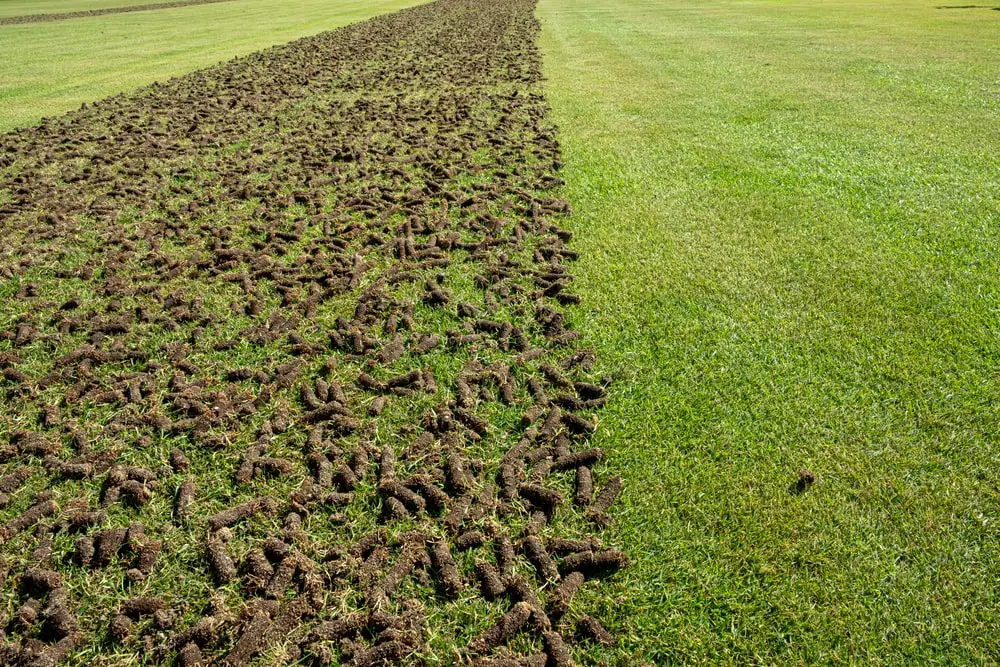
The Grounds Guys provide a comprehensive guide to rejuvenating your lawn for the next season.
|
Last Updated July 17, 2023
Take certain measures to ensure your grass returns with full force next spring.
These include dethatching, aerating, and seeding your lawn. Once you learn why these steps are important and how to perform them, you can be sure to have a beautiful yard for years to come.
Dethatching Your Lawn

Most lawns experience areas where the grass dies just above the soil. Known as thatch, this layer of dead grass is beneficial in small amounts. However, when thatch builds up too quickly, it prevents water and air from reaching your grass, which can cause widespread brown patches. Therefore, your lawn must be dethatched.
Dethatching is a mechanical process that removes the inhibiting layer of dead grass for a healthier, greener lawn. You know it’s time for dethatching if more than a half-inch of dead grass has built up and has begun to weaken your grass. Other signs to look for include thin blades, pale color, and weak growth. Also, if your lawn has a thick layer of thatch, it may feel spongy under your feet.
When Is the Best Time to Dethatch Your Lawn?
If you’re not sure when to dethatch lawn, consider the type of grass on your property. For example, if you're ready to start lawn dethatching cool-season grasses, do it in early spring or early fall. Late spring through early summer is the best time to dethatch warm-season grasses. But for all kinds of grass, the best time to dethatch is when the soil is moderately moist and the lawn is actively growing.
Just as there's a preferable time to dethatch a lawn, there's also a time when you shouldn't. Lawn dethatching at the wrong time can damage your lawn. Don’t dethatch a lawn when it's dormant or stressed. When in doubt, ask a local expert from The Grounds Guys. We’re happy to answer questions about when to begin the dethatching process.
How Often Should You Dethatch Your Lawn?
Thatch builds up over time, so for some grass varieties, dethatching is not something you need to do yearly. However, other varieties should be dethatched once a year. These include cool-season grasses such as Kentucky Bluegrass and Creeping Bent grass. Some warm-season grasses such as Zoysia grass and Bermuda grass benefit from annual lawn dethatching
How to Dethatch Your Lawn
There are some general guidelines that you can apply to any dethatching process. The optimal tools used and specific instructions can vary according to the size of the affected space.
General dethatching tips:
- Water your lawn the day before you plan to dethatch.
- Mow your grass to half its normal height.
- Flag sprinkler heads and other hidden objects to prevent damage.
- Dethatch in two directions at a 90-degree angle from one another.
- If thatching leaves bare spots, reseed your lawn.
- Water the lawn well to help the grass recover.
- Aerate regularly in the future to prevent thatch build-up.
- Dethatching your lawn with a convex rake
Detatching your lawn with a convex rake:

If you only have a small patch of affected grass, a convex rake is an adequate dethatching tool. It can remove thatch up to 1 inch thick without placing too much stress on your lawn. The specialized rake features sharpened tines able to lift thatch away from the soil surface.
When dethatching with a convex rake, use the same motion as traditional raking. Dig the tines into the thatch and pull upward to loosen and lift it out of the soil.
Dethatching your lawn with a power rake:

For larger spaces, you’ll undoubtedly refer to a power rake, also called a vertical cutter or verticutter. You can rent a power rake from a hardware store if you want to complete the job yourself.
Be sure to ask if the blades are spaced properly for your type of grass. Also, ask the rental company to adjust the cutting depth so the blades go no deeper than one-half inch into the soil, if at all.
Be aware that this equipment is large and requires some muscle to maneuver. You’ll also need a truck to transport it to your home and a second person to help load and unload it.
Aerating Your Lawn

As time goes on, soil naturally compacts. Aeration perforates the soil to allow air, water, and nutrients to reach grass roots. It also removes mild thatch. This helps roots grow deeper, making the lawn more vigorous and drought-resistant.
When Should You Aerate Your Lawn?
You should aerate lawns when grass is in its peak growing period. Aerating your lawn during this time will help it to recover quicker. So, just as with dethatching, aerating for cool-season grasses is best done in early spring or fall. For warm-season grasses, the best time to aerate is late spring through early summer.
How Often Should You Aerate Your Lawn?
How often you should aerate your lawn depends on its soil type. For example, lawns grown on clay soils benefit from yearly lawn aeration. You’ll want to aerate lawns growing on loam or sandy soil every two to three years. Note: Your lawn may need to be aerated yearly if it’s subject to heavy foot traffic. It is possible to aerate your lawn too much. Yearly lawn aeration is a safe bet in most cases. But if your grass is healthy, thriving, and doesn’t get a lot of heavy foot traffic, it won’t require lawn aeration very often. If your lawn receives regular maintenance and is performing well, you can aerate it every two to three years.
How to Aerate Your Lawn
You have two main tools to choose from for the job: a spike aerator and a plug aerator. While it may seem sufficient to poke holes in the soil with a spike aerator, this doesn’t remove any soil mass and may actually lead to increased compaction near the holes.
For the best results, use a plug aerator, which removes plugs of grass and soil 2 to 3 inches deep and 0.5 to 0.75 inches wide. You can rent such a machine from a garden store if you wish to perform the job yourself.
Steps for aerating your lawn:
Water your lawn the day before you plan to aerate the soil. Make a single pass over the whole lawn and multiple passes over especially compact areas. Allow the excavated soil plugs to dry, and then break them up with a lawn mower or the back of a rake. Continue basic lawn care practices, including fertilizing, mowing, and watering.
Seeding Your Lawn
.webp)
The summer heat often leaves grass looking pitiful and scorched. Dead brown patches or thinning sections certainly don’t add to your home’s curb appeal. Seeding can fill in bare patches and replace sections of dethatched grass for a more beautiful lawn next season. Even if your lawn is still healthy and green, overseeding can further fill out the grass and make it even lusher come spring.
When to Seed Your Lawn
Lawn seeding can be performed at any time of the year. However, fall is the best time to seed your lawn. This is because the cooler temperatures help new seeds retain moisture, germinate successfully, and become established without battling extreme summer heat. When early fall arrives, annual crabgrass and broadleaf weeds are dying, which helps new turf establish with little competition.
If you’re lawn seeding in spring, chances are good that the seeds will grow. But early spring is also the time to add pre-emergent weed control, which can harm the new turf. However, if your goal is to patch a few small, bare spots, go ahead and do it.
Late spring and summer are not the best time for lawn seeding, especially if you plan to seed large sections on your property or the entire lawn. Your new turf will constantly be competing with crabgrass and weeds.
How Often Should You Seed Your Lawn?
Seeding your lawn ensures that your grass stays thick and dense, which can prevent weeds from invading. However, it’s not something you need to do every year. The overall condition of your lawn and how much foot traffic it receives are factors to consider when deciding when to seed your lawn. If your grass looks tired and worn out, lawn seeding is an excellent way to rejuvenate it. You can seed it every three to four years, which can help to re-establish your lawn before foot traffic thins it out.
How to Seed Your Lawn
Start by reading the grass seed label to make sure you choose the right product for your lawn. You may want a seed blend that features two or more cultivars of the same species, such as fescue, in the same bag. This may help improve the appearance of your lawn.
Also, examine the coverage chart on the grass seed label to determine how much seed you should spread per square foot. Compare this to the drop rate of your broadcast or hand spreader to ensure you lay down the right amount of seed.
Seeding an existing lawn:
- Mow the grass lower than usual.
- Dethatch and/or aerate the lawn, if needed, using the instructions in the above sections.
- Sprinkle the lawn with fertilizer.
- Apply the seed with a broadcast or hand spreader.
- Rake the seeds loosely.
- Water normally.
Fixing bare spots:
- Test whether the damage is caused by pests and take proper pest control measures if needed.
- Remove dead grass and rake the soil to loosen it.
- Spread grass seed.
- Rake the seeds loosely.
- Apply a thin layer of weed-free straw to help keep the seed and loose soil in place.
- Water the reseeded area frequently and shallowly to keep the soil moist without drowning or washing away the seeds.
Why Choose The Grounds Guys for Lawn Maintenance Services?
If you’re uncertain about dethatching, aerating, and seeding your lawn, you don’t have to do the job yourself. Leave the time-consuming and often labor-intensive yard work to our professionals! The Grounds Guys have got you covered when you need dethatching, aerating, and seeding.
The Grounds Guys ensure that your property will always look better than when we found it! You can count on our uniformed professionals to arrive in clean, branded vehicles on time. We use safe, reliable equipment that is maintained daily, and we prefer to use eco-friendly alternatives to chemicals. Whether you lack time, experience, or confidence, count on The Grounds Guys to complete your turf maintenance services for you! Contact us today for dethatching, aerating, seeding, and all your other lawn care needs!